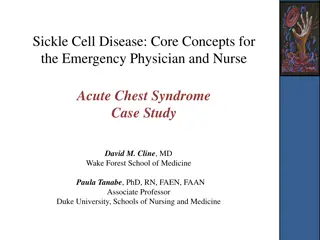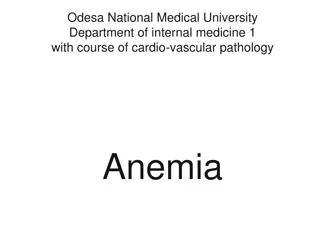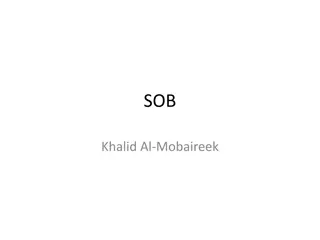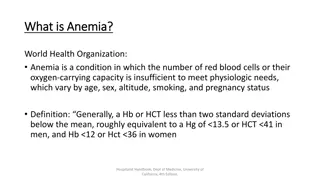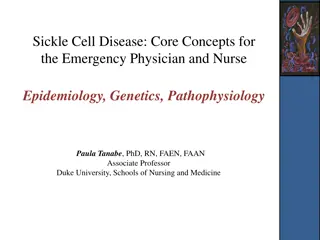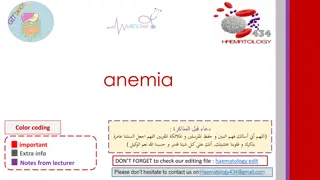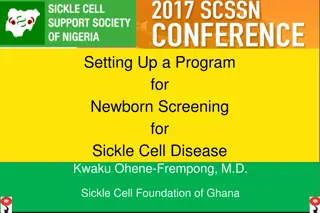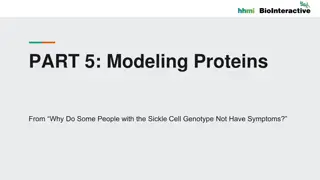Understanding Sickle Cell Anemia: Causes, Symptoms, and Pathophysiology
Sickle cell anemia is an inherited disorder affecting red blood cells' shape, leading to decreased oxygen delivery and various symptoms like fatigue, pain episodes, and more. The condition arises from a genetic mutation affecting hemoglobin production. Individuals with sickle cell trait may not display symptoms but can pass the gene to their offspring. The pathophysiology involves the formation of abnormal hemoglobin (HbS) that causes red blood cells to take a rigid, sickle-like shape when deoxygenated. Early detection and management are crucial in addressing the challenges posed by sickle cell anemia.
Download Presentation

Please find below an Image/Link to download the presentation.
The content on the website is provided AS IS for your information and personal use only. It may not be sold, licensed, or shared on other websites without obtaining consent from the author. Download presentation by click this link. If you encounter any issues during the download, it is possible that the publisher has removed the file from their server.
E N D
Presentation Transcript
SICKLE CELL ANEMIA SICKLE CELL ANEMIA BY SWARNAKSHI UPADHYAY ASSISTANT PROFESSOR SCHOOL OF PHARMACEUTICAL SCIENCES, CSJM UNIVERSITY
DEFINITION DEFINITION Sickle cell anemia is one of a group of inherited disorders known as sickle cell disease. It affects the shape of red blood cells, which carry oxygen to all parts of the body. Red blood cells are usually round and flexible, so they move easily through blood vessels. In sickle cell anemia, some red blood cells are shaped like sickles or crescent moons. These sickle cells also become rigid and sticky, which can slow or block blood flow.
SYMPTOMS SYMPTOMS Anemia. Sickle cells break apart easily and die. Red blood cells usually live for about 120 days before they need to be replaced. But sickle cells typically die in 10 to 20 days, leaving a shortage of red blood cells (anemia). Without enough red blood cells, the body can't get enough oxygen and this causes fatigue. Episodes of pain Swelling of hands and feet. Frequent infections Delayed growth or puberty Vision problems
CAUSES CAUSES Sickle cell anemia is caused by a change in the gene that tells the body to make the iron-rich compound in red blood cells called hemoglobin. Hemoglobin enables red blood cells to carry oxygen from the lungs throughout the body. The hemoglobin associated with sickle cell anemia causes red blood cells to become rigid, sticky and misshapen. For a child to be affected, both mother and father must carry one copy of the sickle cell gene also known as sickle cell trait and pass both copies of the altered form to the child.
If only one parent passes the sickle cell gene to the child, that child will have the sickle cell trait. With one typical hemoglobin gene and one altered form of the gene, people with the sickle cell trait make both typical hemoglobin and sickle cell hemoglobin. Their blood might contain some sickle cells, but they generally don't have symptoms. They're carriers of the disease, however, which means they can pass the gene to their children.
PATHOPHYSIOLOGY PATHOPHYSIOLOGY HbS is produced when there is a point mutation at position 6 of -globin chain which change the glutamic acid to non- polar valine. The absence of polar amino acid in position 6 of -globin promote non-covalent polymerisation of haemoglobin when it is deoxygenated form. The polymerisation causes change in shape of red blood cell (sickle).
COMPLICATIONS COMPLICATIONS Stroke Acute chest syndrome Pulmonary hypertension Organ damage Splenic sequestration Blindness Leg ulcers Gallstones Priapism Deep vein thrombosis Pregnancy complications



